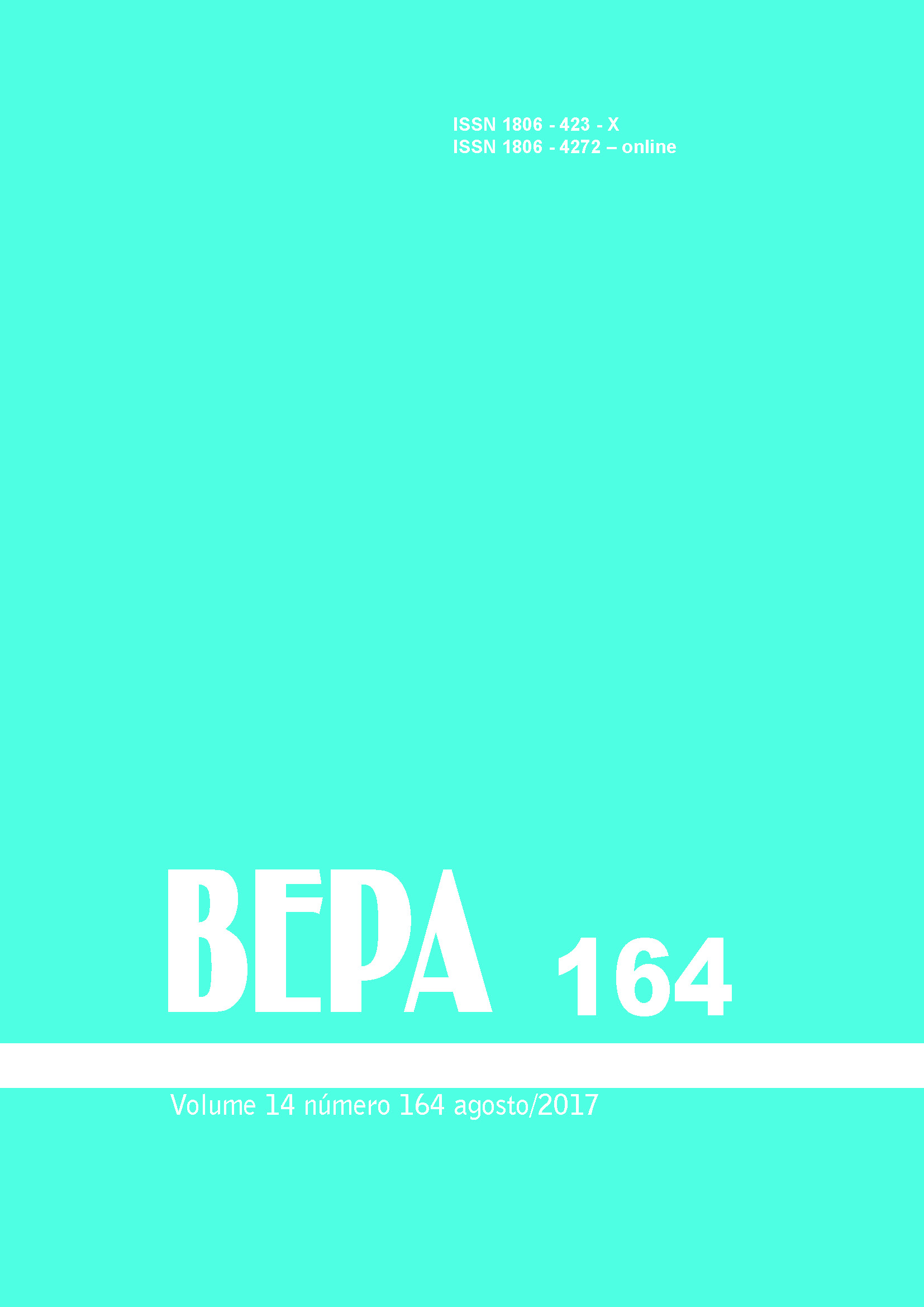Abstract
Shigellosis has been recognized by the World Health Organization (WHO)
as a major global public health problem. Shigella genus is consisted of
four species, Shigella dysenteriae, Shigella flexneri, Shigella boydii and
Shigella sonnei. The aim of this study was to characterize shigellosis as
a public health problem through a retrospective study of reports on the
occurrence of food outbreaks chiefly involving the Shigella genus in the
geographical regions of Brazil; and to compare these data with those from
other developed and developing countries. Data regarding shigellosis
in Brazil between 1970 and 2013 were evaluated. The southeastern
region of Brazil showed the highest number of reports, being S.sonnei
the prevalent species. However, the northern and northeastern regions
reported the highest percentages of morbidity caused by shigellosis,
mostly associated with S. flexneri. During the studied period, S. flexneri
was the predominant species in Brazil as a whole, followed by S. sonnei,
S. dysenteriae and S. boydii. The proportion of food outbreaks due to
Shigella in studies on different etiologic agents ranged from 1.4 to 19.4%
with predominance of S. sonnei; and this species was responsible for
60% of the cases in the five reports on shigellosis outbreaks. Only one
report was found in the southern and none in the midwestern regions of
Brazil. Education and improved public healthcare can help to reduce
the incidence of shigellosis; and the innovative strategies, such as the
development of vaccines, would provide substantial benefits to the
population.
References
World Health Organization. Guidelines
for the control of shigellosis,
including epidemics due to shigella
dysenteriae type 1. Geneva; 2005.
Trabulsi LR, Alterthum F. Microbiologia.
ed. São Paulo: Atheneu, 2008.
Niyogi SK. Shigellosis. J.
microbiol. 2005;43(2):133-43.
Centers for Disease Control and
Prevention. Shigellosis outbreak
associated with an unchlorinated filland-drain wading pool - Iowa, 2001.
MMWR. 2001;50(37):797– 800.
Nygren BL, Schilling KA, Blanton
EM, Silk BJ, Cole DJ, Mintz ED.
Foodborne outbreaks of shigellosis
in the USA, 1998-2008. Epidemiol.
infect. 2013;141(2):233-41.
Trofa AF, Ueno-Olsen H, Oiwa R,
Yoshikawa M. Dr. Kiyoshi Shiga:
Discoverer of the dysentery bacillus.
Clin. infect. dis. 1999;29(5):1303-6.
Winn WJr, Allen S, Janda W, Koneman
E, Procop G, Schreckenberger P,
et al. Diagnóstico microbiológico:
texto e atlas colorido. 6. ed. Rio de
Janeiro: Guanabara Koogan; 2008.
Veronesi R, Focaccia R. Tratado de
Infectologia. São Paulo: Atheneu; 1996.
Erqou S, Teferra E, Mulu A, Kassu A.
A case of Shigellosis with Intractable
Septic Shock and Convulsions. Jpn.
j. infect. dis. 2007;60(5):314-6.
Levine OS, Levine MM. House flies
(Musca domestica) as mechanical
vectors of shigellosis. Rev. infect.
dis. 1991;13(4):688-96.
Centers for Diseases Control and
Preventions. Foodborne Diseases Active
Surveillance Network (FoodNet):
foodNet surveillance report for 2012
(final report). Georgia: Department of
Health and Human Services; 2014.
Naumova EN, Jagai JS, Matyas B,
DeMaria A Jr, MacNeill IB, Griffiths JK.
Seasonality in six enterically transmitted
diseases and ambient temperature.
Epidemiol. infect. 2007;135(2):281-92.
Nunes MRCM, Magalhães PP, Penna
FJ, Nunes JMM, Mendes EN. Diarrhea
associated with Shigella in children
and susceptibility to antimicrobials. J.
pediatr. (Rio J.). 2012; 88(2):125-8.
Levine MM, Kotloff KL, Barry
EM, Pasetti MF, Sztein MB. Clinical
trials of Shigella vaccines: two steps
forward and one step back on a long,
hard road. Nat. rev. microbiol.
;5(7):540–5
Barry EM, Pasetti MF, Sztein MB,
Fasano A, Kotloff KL, Levine MM.
Progress and pitfalls in Shigella vaccine
research. Nat. rev. gastroenterol.
hepatol. 2013;10(4):245–55.
Camacho AI, Souza-Rebouças J, Irache
JM, Gamazo C. Towards a non-living
vaccine against Shigella flexneri: from
the inactivation procedure to protection
studies. Methods. 2013;60(3):264-8.
Noriega FR, Liao FM, Maneval DR,
Ren S, Formal SB, Levine MM.
Strategy for cross-protection among
Shigella flexneri serotypes. Infect.
immun. 1999;67(2):782-8.
Ashkenazi S, Cohen D. An update
on vaccines against Shigella. Ther
Adv Vaccines. 2013;1(3):113–23.
Peirano G, Agersø Y, Aarestrup FM,
Rodrigues DP. Occurrence of integrons
and resistance genes among sulphonamideresistant Shigella spp from Brazil. J.
antimicrob. chemother. 2005;55(3):301-5.
Sousa MAB, Mendes EN, Collares GB,
Péret-Filho LA, Penna FJ, Magalhães
PP. Shigella in Brazilian children with
acute diarrhoea: prevalence, antimicrobial
resistance and virulence genes. Mem.
Inst. Oswaldo Cruz. 2013;108(1):30-5.
Pourakbari B, Mamishi S, Mashoori N,
Mahboobi N, Ashtiani MH, Afsharpaiman
S et al. Frequency and antimicrobial
susceptibility of Shigella species
isolated in Children Medical Center
Hospital, Tehran, Iran, 2001-2006.
Braz. j. infect. dis. 2010;14(2):153-7.
Peirano G, Souza FS, Rodrigues DP.
Frequency of serovars and antimicrobial
resistance in Shigella spp. Mem. Inst.
Oswaldo Cruz. 2006;101(3):245-50.
Cheasty T, Day M, Threlfall EJ.
Increasing incidence of resist¬ance
to nalidixic acid in shigellas from
humans in England and Wales. Clin.
microbial. infect. 2004;10(11):1033-5.
Chuang YY, Huang YC, Lin SY. Outbreak
of Shigella sonnei gastroenteritis
in Northeastern Taiwan. Pediatr.
infect. dis. j. 2006;25(1):92-4.
Khan E, Jabeen K, Ejaz M, Siddiqui
J, Shezad MF, Zafar A. Trends in
antimicrobial resistance in Shigella
species in Karachi, Pakistan. J. infect.
Dev. ctries. 2009;3(10):798-802.
Centers for Diseases Control and
Preventions. Preliminary FoodNet
Data on the Incidence of Infection with
Pathogens Transmitted Commonly Through
Food – 10 Sites. United States; 2004.
Miyagi K, Takegaki Y, Nakano T, Nakano
Y, Honda T, Sano K. Frequency of failure
to isolate Shigella spp. by the direct
plating technique and improvement of
isolation by enrichment in selenite broth.
Epidemiol. infect. 2001;127(2):375-9.
Alamanos Y, Maipa V, Levidiotou S,
Gessouli E. A community waterborne
outbreak of gastro-enteritis attributed
to Shigella sonnei. Epidemiol.
infect. 2000;125(3):499-503.
Arias C, Sala MR, Domínguez A,
Bartolomé R, Benavente A, Veciana P
et al. Waterborne epidemic outbreak of
Shigella sonnei gastroenteritis in Santa
Maria de Palautordera, Catalonia, Spain.
Epidemiol. infect. 2006;134(3):598-604.
Godoy P, Bartolomé R, Torres J, Espinet
L, Escobar A, Nuin C et al. Brote de
gastroenteritis por el consumo de agua de
suministro público causado por Shigella
sonnei. Gac. sanit. 2011;25(5):363-7.
Kapperud G, Rørvik LM, Hasseltvedt V,
Høiby EA, Iversen BG, Staveland K et
al. Outbreak of Shigella sonnei infection

This work is licensed under a Creative Commons Attribution 4.0 International License.
Copyright (c) 2017 Naiady Konno Madela, Elisabete Cardiga Alves, Denise Fusco Marques, Jacqueline Tanury Macruz Peresi, Ivete Aparecida Zago Castanheira de Almeida
